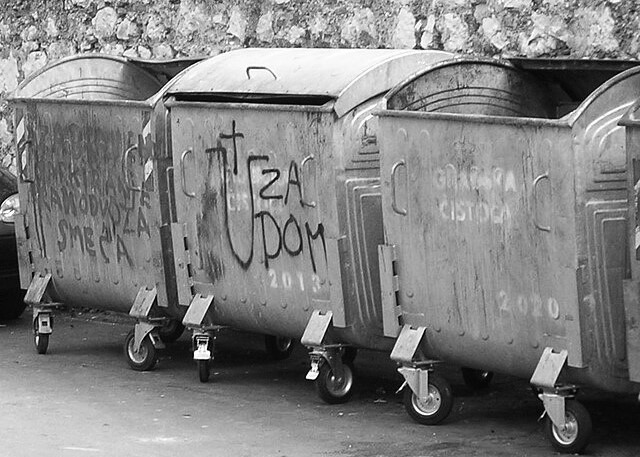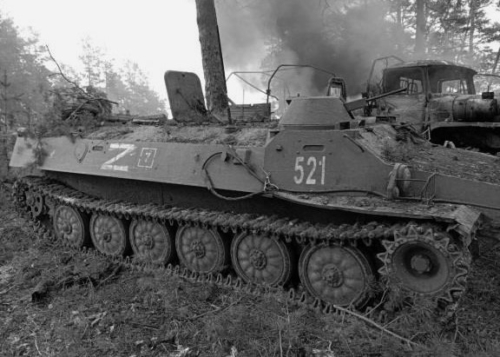Abstract: What happens when the future loses its place in our cultural imagination—not as a speculative tool or techno-utopia, but as a generative and affectively charged dimension of political and social life? And how might we cultivate futures thinking in contexts where the very notion of ‘moving forward’ is contested terrain? Drawing on the experiences of conflict-affected and post-conflict societies, Katarina Damčević argues that the futures we can imagine—and who gets to imagine them—depend on the semiotic frameworks we inherit, challenge, and reshape. Drawing from semiotics, peace and conflict studies, and memory studies, she explores how moments of cultural turbulence can turn contested signs and symbols into grounds not only for friction, but also for constructive, hopeful transformation.
Photo: Peccafly, Public domain, via Wikimedia Commons
Generate PDF
[…] the idea of the future is one of the central symbols through which human beings have ordered their present and have given meanings to the past. Whilst futures research in the academic sense is a recent pursuit, conjecture, speculation, and exploration of future events have always been prime features of the human condition.
— McHale, 1978: 5[1]
doi number
doi: 10.15457/frictions/0043
What happens when the future loses its place in our cultural imagination—not as a speculative tool or techno-utopia, but as a generative and affectively charged dimension of political and social life? And how might we cultivate futures thinking in contexts where the very notion of ‘moving forward’ is contested terrain? These questions are far from abstract. They emerge in post-conflict societies burdened by unresolved pasts and polarized presents. They become particularly urgent in the face of war, ecological breakdown, and the erosion of political trust. As the Dutch sociologist Fred Polak once argued,[2] a society with no positive images of the future indicated a society in decline. Yet, what futures can be imagined—and by whom—depends on the semiotic frameworks we inherit, contest, and reconfigure.
While interest in the future has always been present, more concrete investigations appeared after World War Two in the form of strategic planning, technological forecasting, economic analysis, and the creation of the first major think tanks.[3] The field of futures studies originated in the 1960s and 1970s, a period marked by significant contributions such as Alvin Toffler’s Future shock (1970) and Edward Goldsmith’s Blueprint for survival (1972).
Oppressive governments, political agendas, exclusive norms and customs, as well as education systems grounded in hegemonic myths and narratives, can leave little or no space for alternatives. During crises and conflicts—as well as in post-conflict contexts burdened by violent pasts, traumas, and fraught historical narratives—opening the space to explicitly address and explore hopeful future scenarios can be significantly more challenging.
Futures studies theories and methods became of further interest for peace and conflict studies[4] and peace education.[5] For instance, in a more detailed overview of Elise Boulding’s scholarly contribution, David Hicks (2007) emphasizes Boulding’s collaboration with the futurist Warren Ziegler, which she describes in more detail in her book Building a Global Civic Culture: Education for an Interdependent World (1988). One of Boulding’s significant insights arose from this collaboration and her work with peace activists. Namely, she came to realize that, while peace activists had a clear idea of what they opposed, they found it difficult to visualize what they were for and how they envision their preferred future. Boulding continued working with various groups and exploring the role of social imagination, along with whether people can genuinely imagine a hopeful future when placed in an appropriately facilitative environment.[6]
However, possibilities for imagining hopeful futures and potential scenarios can be hindered by various factors. Oppressive governments, political agendas, exclusive norms and customs, as well as education systems grounded in hegemonic myths and narratives, can leave little or no space for alternatives. During crises and conflicts—as well as in post-conflict contexts burdened by violent pasts, traumas, and fraught historical narratives—opening the space to explicitly address and explore hopeful future scenarios can be significantly more challenging.
The Semiotics of the Future
In the words of the semiotician Katre Pärn, semiotics allows us to explore how future-making is mediated through signs, models, and cultural codes—often collectively, not merely individually.[7] Futures are not “out there,” waiting to be discovered. They are continuously constructed, modeled, and negotiated. And crucially, these constructions are as affective as they are cognitive, steeped in imaginaries of hope, fear, irony, and belonging.
Following the thoughts of Juri Lotman—the semiotician and literary scholar—and his concept of cultural explosion,[8] unpredictability flourishes in moments of rupture—where meaning becomes unstable, codes clash, and established narratives no longer suffice.[9] This semiotic turbulence, though unsettling, is also fertile ground. It generates new political imaginaries, hybrid narratives, and possibilities for transformation. Contestation, in this light, can be generative as much as it can be destructive.
Contestation as Meaning-Making
Take, for instance, the debates around contested symbols in post-Yugoslav Croatia. The World War Two Ustaša salute “Za dom spremni” (“Ready for the Homeland”) operates simultaneously as a historical marker, a political tool, and an affective trigger.[10] It evokes fear, pride, irony, and anger—all depending on who is looking, from where, and under what circumstances. Accordingly, such symbols do not merely reflect polarized memories—they actively shape the future by constraining or enabling the horizons of political possibility.
Similarly, in the context of the full-scale Russian invasion of Ukraine, symbolic contestation is palpable in the weaponization of historical narratives and the affective charge of war symbols—such as Russia’s “Z” (“Za pobedu” [за победу – for victory]) or “V” (“Sila v pravde” [сила в правде – strength in truth]), memes, monuments, and other military insignia. These symbols do more than represent—they mobilize, divide, and reconfigure collectives. They become dynamic semiotic condensers through which histories are re-narrated, legal claims are asserted, belonging is negotiated, and legacies created.
This semiotic turbulence, though unsettling, is also fertile ground. It generates new political imaginaries, hybrid narratives, and possibilities for transformation. Contestation, in this light, can be generative as much as it can be destructive.
Left photo: First part of the salute with an Ustaša symbol (U) sprayed on a dumpster | © Photo: User Peccafly, Public domain, via Wikimedia Commons
Right photo: Russian MT-LB in Ukraine marked with an “Z” | © Dpsu.gov.ua, CC BY 4.0 , via Wikimedia Commons
Why Futures Thinking Matters
In such volatile contexts, futures thinking becomes both a method and a mode of resistance. During crises, we find ourselves in a limbo of binary thinking and a heightened perception of narrowed possibilities. This cognitive, affective, and discursive deficit can hinder meaningful change, be it on the individual or collective level. Futures thinking helps us bridge that gap, not by predicting outcomes, but by opening imaginative and participatory spaces for alternative scenarios.
This is particularly important in education, media, and policymaking, where dominant narratives can either foreclose or facilitate new pathways. The concept of futures consciousness—as approached by Ahvenharju, Minkkinen, and Lalot, and grounded in the importance of human awareness—encompasses dimensions such as time perspective, agency beliefs, openness to alternatives, and concern for others.[11] These are not abstract values; they are cultivated capacities that shape how we respond to unpredictability. In contexts of prolonged conflict or trauma, cultivating these capacities is especially challenging, but also essential. Futures thinking, in this view, becomes a form of care: for the self, for the collective, and for the not-yet. It offers not escape, but engagement. Not closure, but curiosity.
During various types of cultural explosions—be it wars or revolutions—affect and semiosis coalesce in powerful and at times dangerous or undemocratic ways. But they can also be reoriented towards democratic expression, identity renegotiation, and creative resistance.
Symbols, Affect, and Imagination
Building on the role of symbolic contestation, approaching futures through a semiotic lens means we must analyze not just what symbols mean, but how they make us feel, act, and imagine. Futures thinking is deeply affective. It invites us to consider how fear can block alternatives, how irony can subvert the hegemonic, and how hope and longing can become a political resource. During various types of cultural explosions—be it wars or revolutions—affect and semiosis coalesce in powerful and at times dangerous or undemocratic ways. But they can also be reoriented towards democratic expression, identity renegotiation, and creative resistance.[12] This is also the transformative promise of futures thinking—not as utopia, but as a semiotic practice of disruption, invention, and care.
To nurture futures thinking and awareness amid uncertainty is to accept that meaning is always in flux. It is to recognize that symbols are not just about the past—they are tools for shaping what comes next. And in the face of conflict and crises, such practices are not a luxury. They are a necessity. We must ask: What futures do our symbols make possible? And how might we imagine otherwise?
Notes & References
[1] McHale, J. (1978). The emergence of futures research. In: J. Fowles (Ed.), The Handbook of Futures Research. Greenwood Press.
[2] Polak, F. (1972). The Image of the Future. Translated and abridged by Elise Boulding. Elsevier.
[3] See, e.g., Bell, W., Foundations of Futures Studies (1997), Transaction Publishers; Masini, E. A vision of futures studies (2002). Futures 34(3/4): 249-259; Bishop, C. P., Hines, A., Teaching about the Future (2012). Palgrave Macmillan.
[4] See Boulding, E., Building a global civic culture: Education for an Interdependent World (1988), Teachers College Press.
[5] See, e.g., Hicks, D., Teaching for tomorrow: how can futures studies contribute to peace education?
(published online 2007). Journal of Peace Education 1(2): 165-178.
https://www.tandfonline.com/doi/abs/10.1080/1740020042000253721
[6] Boulding, E., Building a global civic culture (1988), Teachers College Press.
[7] Pärn, K. (2021). Towards the semiotics of the future: From anticipation to premediation. Sign Systems Studies 49(1/2): 108-131.
[8] Lotman, M. J. (2009[1992]). Culture and Explosion. Edited by Marina Grishakova. De Gruyter Mouton.
[9] Lotman, M. J. (2013). The Unpredictable Workings of Culture. Edited by Silvi Salupere and I. A. Pilshchikov. TLU Press.
[10] Damčević, K. (2023). Cultural texts, enemies, and taboos: autocommunicative meaning-making surrounding the “Ready for the Homeland” Ustaša salute in Croatia. Social Semiotics 33(3): 470-496.
[11] Ahvenharju, S., Minkkinen, M., Lalot, F. (2018). The five dimensions of Futures Consciousness. Futures 104: 1-13.
[12] Serbia’s Protests as a Cultural Explosion: Symbols, Memory, and the Struggle for Meaning
© 2025. This text is openly licensed via CC-BY. The images are not subject to a CC licence.





